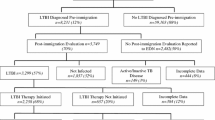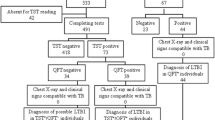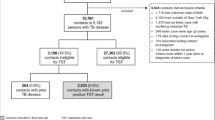Abstract
The prevalence of latent tuberculosis infection (LTBI) in the various populations of New York City (NYC), a city with a high density of non-US-born persons, is unknown. We examined the prevalence of TST positivity in patients who received a tuberculin skin test (TST) between 1/2002 and 8/2004 at any of 10 NYC health department chest centers. A positive TST was defined as an induration reaction to tuberculin of ≥10 mm. In the study population of 41,022 individuals, prevalence of TST positivity was 24.4% (95%CI = 24.0, 24.8); four times higher among non-US-born persons than US-born (39.5% vs. 8.8%, Prevalence ratio (PR) = 4.5; 95%CI = 4.4, 4.6). Prevalence of TST positivity increased with age in both US and non-US-born persons. Persons from countries with a TB case rate >100/100,000 population had higher prevalence of TST positivity (47% vs. ≤39%), even after controlling for BCG (PR = 1.3, 95%CI = 1.2, 1.4). These findings provide insight into current prevalence of TST positivity in many immigrant populations and will help both clinicians and health departments to target patients for LTBI treatment.


Similar content being viewed by others
References
Centers for Disease Control and Prevention (CDC). Targeted tuberculin testing and treatment of latent tuberculosis infection. Morb Mortal Wkly Rep. 2000;49(RR-6):1–51.
Institute of Medicine (US). Committee on the Elimination of Tuberculosis in the United States. In: Geiter L, editor. Ending neglect: the elimination of tuberculosis in the United States. Washington, DC: National Academy Press; 2000.
Centers for Disease Control, Prevention (CDC). Reported Tuberculosis in the United States, 2006. Atlanta, GA: U.S. Department of Health and Human Services, CDC; 2007.
New York City Department of Health and Mental Hygiene: Tuberculosis in New York City, 2005: Annual Summary. New York City Department of Health and Mental Hygiene; 2006.
Bennett DE, Courval JM, Onorato I, Agerton T, Daugherty Gibson J, Lambert L, et al. Prevalence of tuberculosis infection in the U.S. population. Am J Respir Crit Care Med. 2007;177(3):348–55.
Joos TJ, Miller WC, Murdoch DM. Tuberculin reactivity in bacilli Calmette-Guerin vaccinated populations: a compilation of international data. Int J Tuberc Lung Dis. 2006;10(8):883–91.
New York City Department of City Planning. 2000 census profiles. Available at: http://www.nyc.gov/html/dcp/pdf/census.shtml.
US Census Bureau. United States Census 2000: demographic profiles in the Unites States. Available at: http://censtats.census.gov/data/US/01000.pdf.
Fujiwara PI, Munsiff SS, Shapiro D. Testing and treatment for latent tuberculosis infection. City Health Information. New York: New York City Department of Health. 2000 Oct; 19(3). Available at: http://home2.nyc.gov/html/doh/downloads/pdf/chi/chi19-3.pdf.
World Health Organization (WHO). Global tuberculosis control: surveillance, planning, financing. WHO Report 2005. Geneva, Switzerland, WHO/HTM/TB/2005.349.
World Health Organization. WHO vaccine-preventable diseases: monitoring system: 2005 global summary. Geneva, Switzerland: WHO; 2005. WHO/IVB/2005. Available at www.who.int/vaccines-documents/.
Greenland S. Model-based estimation of relative risks and other epidemiologic measures in studies of common outcomes and in case-control studies. Am J Epidemiol. 2004;160:301–5.
Spiegelman D, Hertzmark E. Easy SAS calculations for risk or prevalence ratios and differences. Am J Epidemiol. 2005;162:199–205.
Pearce N. Effect measures in prevalence studies. Environ Health Perspect. 2004;112:1047–50.
Pai M, Riley LW, Colford JM Jr. Interferon-γ assays in the immunodiagnosis of tuberculosis: a systematic review. Lancet Infect Dis. 2004;4:761–76.
Mazurek GH, Jereb J, LoBue P, Iademarco MF, Metchock B, Vernon A, et al. Guidelines for using the QuantFERON-TB Gold test for detecting Mycobacterium tuberculosis infection, United States. MMWR Recomm Rep. 2005;54(RR-15):49–55.
Pai M, Dheda K, Cunningham J, Scano F, O’Brien R. T-cell assays for the diagnosis of latent tuberculosis infection: moving the research agenda forward. Lancet Infect Dis. 2007;7(6):428–38.
Nolan CM, Goldberg SV, Buskin SE. Hepatotoxicity associated with isoniazid preventive therapy: a 7-year survey from a public health tuberculosis clinic. JAMA. 1999;281:1014–18.
Salpeter SR, Sanders GD, Salpeter EE, Owens DK. Monitored isoniazid prophylaxis for low-risk tubercullin reactors older than 35 years of age: a risk-benefit and cost-effectiveness analysis. Ann Intern Med. 1997;127:1051–61.
Schluger NW, Huberman R, Wolinsky N, Dooley R, Rom WN, Holzman RS. Tuberculosis infection and disease among persons seeking social services in New York City. Int J Tuberc Lung Dis. 1997;1:31–7.
Hudson J, Van Zetta S, Brissette B, Driver CR, Macaraig M, Winters A, et al. Tuberculosis transmission in a homeless shelter population–New York, 2000–2003. MMWR. 2005;54:149–52.
Farhat M, Greenaway C, Pai M, Menzies D. False-positive tuberculin skin tests: what is the absolute effect of BCG and non-tuberculous mycobacteria? Int J Tuberc Lung Dis. 2006;10(11):1192–204.
Acknowledgements
The authors thank Drs. Cynthia R. Driver and Richard Menzies for their thorough review and helpful comments that led to an improved manuscript.
Author information
Authors and Affiliations
Corresponding author
Additional information
The findings and conclusions in this report are those of the authors and do not necessarily represent the views of the Centers for Disease Control and Prevention.
Rights and permissions
About this article
Cite this article
Li, J., Munsiff, S.S. & Agerton, T.B. Prevalence of Tuberculin Skin Test Positivity in Clinical Population in New York City. J Immigrant Minority Health 12, 816–822 (2010). https://doi.org/10.1007/s10903-008-9204-9
Received:
Accepted:
Published:
Issue Date:
DOI: https://doi.org/10.1007/s10903-008-9204-9




